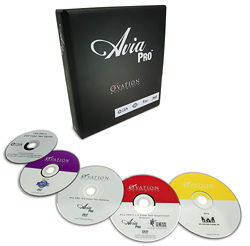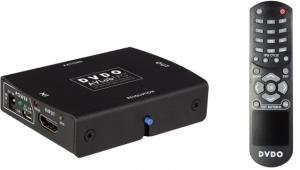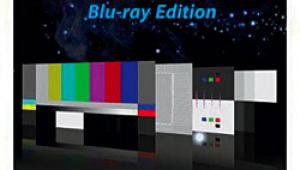Avia Pro
 The selections of tests contained on all three are much the same, but many tests are presented in different ways, making all of the discs useful, even indispensable. Beyond the usual video and audio tests that can be performed without specialized test gear by anyone, video calibration specialists—and reviewers—use the test patterns on these discs to aid in equipment calibration and assessment.
The selections of tests contained on all three are much the same, but many tests are presented in different ways, making all of the discs useful, even indispensable. Beyond the usual video and audio tests that can be performed without specialized test gear by anyone, video calibration specialists—and reviewers—use the test patterns on these discs to aid in equipment calibration and assessment.
But there's a new kid in town. The new Avia Pro system under review here won't likely sell in large numbers to ordinary video enthusiasts at its asking price of $400, nor will it be found in the DVD bins at your local Target or Virgin outlets, but its intended market is not the general public. It's made for professionals: equipment designers, custom installers, ISFers . . . and reviewers. Still, it wouldn't surprise me to see more than one enthusiast invest in the package—especially after seeing just how much it offers.
Something New
Only five of the discs were available to us for this review; the audio test DVD is still being finalized as we go to press. The gem of the lot, and the one I spend the most time describing here, is the Avia Pro 16:9 Video Test Pattern DVD. It contains more than 1000 test signals (not including variants), all of them digitally generated and mastered. Access to the patterns is relatively direct, assuming your DVD player can search for title and chapter.
Many of the patterns are useful for all types of video displays, some are most applicable to CRT setup and assessment, and others are best for fixed-pixel designs. Special encoding solutions were developed for transferring the material to MPEG2 DVD while maintaining low noise, signal-level accuracy, and flat, wide bandwidth. What sort of test patterns can you expect, and how are they better than those available on more affordably priced test discs? I can only scratch the surface here.
The Resolution chart allows you to assess not only the vertical and horizontal resolution, but to check for ringing, frequency response out to 3.58MHz for chroma (color) and 6.75MHz for luma (black and white), overscan, centering, corner resolution, and perfect 1:1 pixel alignment, which will be of interest to fixed-pixel owners and home theater PC enthusiasts. The Sharpness & Peaking pattern repeats some of the Resolution tests, but also provides others designed to optimize sharpness settings for minimum ringing. There are also sweeps for luma (2.0–5.0MHz) and chroma (0.8–2.4MHz). A large, circular Zone Plate pattern lets you test scaler performance at various angles within the picture, with scaling artifacts showing up as moiré patterns.
Video frequency response can be checked visually with Resolution Plate patterns, marked in both MHz and TV lines, and/or an exhaustive array of chroma and luma multiburst and sweep patterns. Patterns are provided with and without frequency annotation.
Dozens of other patterns are devoted to black level, white level, gray-scale tracking, and gamma response. These include needle pulse patterns, gray-scale step, ramp, and window patterns. Particularly interesting are the luma patterns, which increase in level by 10 IRE, 5 IRE, or 2.5 IRE steps. The last one is unique in my experience and extends down to a minimum of 2.5 IRE. It will not only give you a thorough characterization of a video playback system's response in the near-black region, but by measuring all the 2.5 IRE steps you'll have an accurate record of the system's gamma curve. Taking all these measurements individually would be tedious, but automated versions of the patterns are also provided for those with the instrumentation to make use of them. There are also full-field gray patterns at all levels in steps of 2.5 IRE.
Also unique are the so-called Window Quadruplets: separate sequences of four different window patterns each, designed to facilitate gray-scale setup. Any calibrator who has had to constantly jump back and forth between, for example, the 30 IRE pattern in chapter 17-34 of DVE and the 80 IRE pattern in chapter 17-44—a round-trip total of 20 chapter steps—will appreciate the quadruplet sequence of 30-55-80-7.5 IRE provided here, along with a number of other useful quintuplet and quadruplet sets.
Speaking of convenience for the calibration technician, the disc's first three titles provide useful suites of tests for setting the user controls (title 1), CRT calibration (title 2), and fixed-pixel/digital display calibration (title 3)—you don't have to go searching all over the thousands of patterns on the disc to locate those you're likely to use most often.

















































